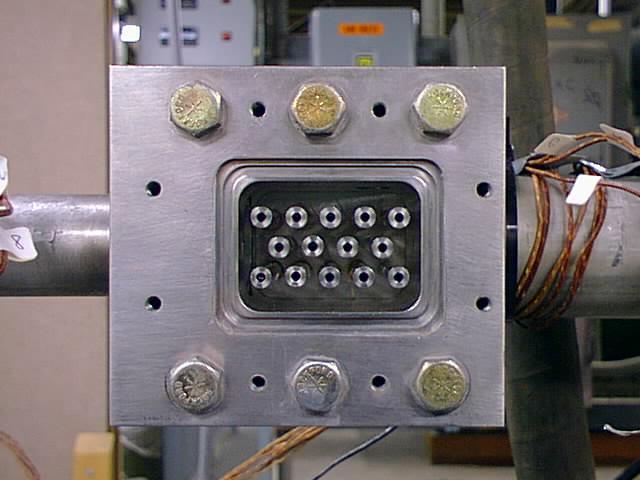
Array of 2 mm ID nozzles supplied by 2.4 MPa water (right) into low pressure manifold at 6 L/s. Heater plate (not shown) sits perpendicular to array. The resulting water jets, at velocities up to 46 m/s, were demonstrated to remove up to 17 MW/m2 over a 5 cm2 area by convection alone.
Extremely High Heat Fluxes
Working heat fluxes in engineered systems have rarely exceeded 10 MW/m2 in steady operation, but trends toward higher power density, such as are encountered in synchrotron x-ray components, laser diode arrays, and fusion systems, create the need for steady operation at heat fluxes well beyond this range. In contrast, intense energy fluxes, such as produced by cutting lasers or plasma arcs, may easily exceed 10 GW/m2, and the associated heat fluxes can be supported only in a transient state unless the heated area is microscopically small. This work focused on identifying fundamental processes and design strategies that can facilitate high steady heat fluxes. At these levels, achievable fluxes are limited as much by the conduction resistance and material strength of the heat transfer surface as by coolant-side processes. Our previous work has led to the highest steady state fluxes produced to date over macroscopic areas (around 400 MW/m2). A primary goal was high flux cooling of large areas and selection of appropriate wall materials. A significant ancillary problem is the development of well-controlled and uniform heat flux sources for high power density experimentation. We have explored the use of thermally-sprayed resistance heaters for this purpose.
Stress-Induced Failure in Materials at Extremely High Heat Fluxes
At heat fluxes of 10 to 100 MW/m2, cooled surfaces are likely to fail as a result of thermal stresses that reach ultimate strength. This study applies analytical and numerical models to investigate the heat fluxes achievable in plates using various heating configurations and different materials. For dimensions and cooling system pressures typical of current systems, elastic behavior can be sustained for fluxes up 20 MW/m2 or so. Plastic effects can enable fluxes to increase by an order of magnitude before failure occurs.